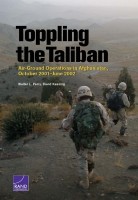| 来源类型 | Research Reports
|
| 规范类型 | 报告
|
| DOI | https://doi.org/10.7249/RR381
|
| ISBN | 9780833082657
|
| 来源ID | RR-381-A
|
| Toppling the Taliban: Air-Ground Operations in Afghanistan, October 2001–June 2002 |
| Walter L. Perry; David Kassing
|
| 发表日期 | 2015
|
| 出版年 | 2015
|
| 页码 | 182
|
| 语种 | 英语
|
| 结论 |
Joint action at the lowest echelons proved effective in Afghanistan- Air-land operations were effective both in the initial campaign to destroy the Taliban regime and in the ensuing hunt for the remnants of al Qaeda and the Taliban.
The type and scale of operations in Afghanistan were unanticipated and were conducted in a harsh, demanding environment.- At the time, existing support locations were far away, and Afghanistan lacked the infrastructure to support the necessary logistics sustainment effort.
- A flexible information system helped ensure that supply systems supporting operations in Afghanistan were able to adapt quickly and respond to rapid and frequent changes in supply delivery points.
Unmanned aerial vehicles proved their worth in Afghanistan.- The success of the Predator and Global Hawk UAVs prompted the services to modify and expand their plans for UAVs.
Coordination of special operations forces (SOF) and conventional forces caused some problems.- SOF often depend on air support for their very survival, yet they were not well integrated with tactical air controllers.
- SOF learned how to call in air support but were not versed in air platforms and weapons. For this, they depended on tactical air control parties, but there were not enough of these at their home stations to meet all requirements, neither were they adequately equipped to support SOF.
The initial focus of the Coalition Joint Civil-Military Operations Task Force on humanitarian aid delayed it from providing more traditional civil affairs assistance.- Tension existed between its mandate to carry out aid and assistance projects and the desire to limit the number of U.S. forces in Afghanistan.
- Additionally, it would have been helpful to deploy civil affairs troops in theater early, but the active force has relatively little civil affairs force structure.
Light forces played a dominant role in Afghanistan because of an elusive enemy operating in rugged terrain.- The Army's Special Forces played a central role in toppling the Taliban and hunting for al Qaeda.
- Coalition forces frequently relied on helicopters to negotiate Afghanistan's difficult terrain.
- The Army's light infantry and air-mobile forces were also well suited to operations in Afghanistan. Ultimately, only dismounted infantry could pursue al Qaeda into its mountainous lairs.
- The Army could not have accomplished its mission in Afghanistan without light forces, both special operations and conventional forces.
|
| 摘要 |
- The Army, in partnership with the other services, must plan and train for joint operations at the brigade and battalion task force level, with air support being pushed to company level and lower.
- Due to the distance from existing support locations and the lack of local infrastructure to support the necessary logistics sustainment effort, OEF revealed the Army's need to improve its readiness to deploy and fight in an austere theater.
- As the Army tailors its support doctrine, it should account for the possibility of supporting a theater where special operations forces mix with conventional forces.
- The Army should continue to pursue its plans to develop tactical unmanned aerial vehicles.
- The Army should develop coordination measures to ensure that conventional forces and special operations forces work together more smoothly and train together on a more regular basis.
- Given its ongoing and likely future role in Afghanistan, the Army should restructure its humanitarian assistance organizations and clarify the Army's humanitarian assistance mission.
- The Army's operational concepts should assume a continued risk of tactical surprise.
|
| 主题 | Afghanistan
; Civil-Military Relations
; Military Strategy
; September 11
; 2001 Terrorist Attacks
; United States Air Force
; United States Army
|
| URL | https://www.rand.org/pubs/research_reports/RR381.html
|
| 来源智库 | RAND Corporation (United States)
|
| 引用统计 |
|
| 资源类型 | 智库出版物
|
| 条目标识符 | http://119.78.100.153/handle/2XGU8XDN/107936
|
推荐引用方式
GB/T 7714 |
Walter L. Perry,David Kassing. Toppling the Taliban: Air-Ground Operations in Afghanistan, October 2001–June 2002. 2015.
|
|
文件名:
|
x1495315139334.jpg
|
|
格式:
|
JPEG
|

|
文件名:
|
RAND_RR381.pdf
|
|
格式:
|
Adobe PDF
|
除非特别说明,本系统中所有内容都受版权保护,并保留所有权利。